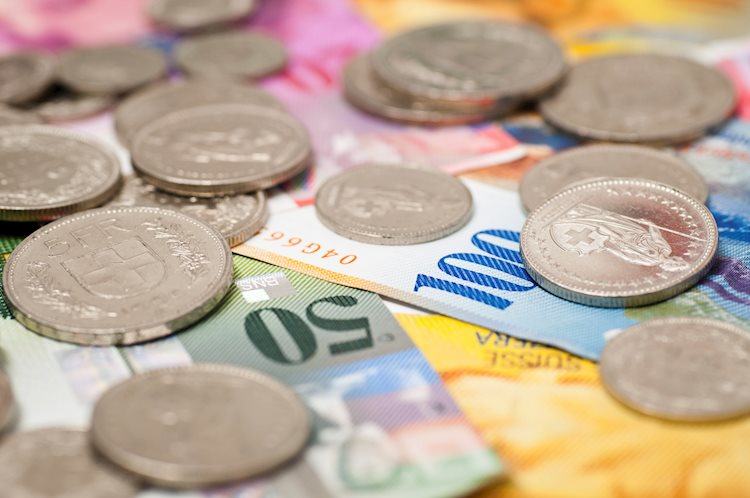- USD/CHF rebounds near 0.8955 in Monday’s early European session.
- The hotter US PPI data on Friday did not change the Fed rate cut expectations in September.
- The political uncertainty underpins the Swiss Franc against the Greenback.
The USD/CHF pair edges higher to 0.8955, snapping the two-day losing streak during the early European session on Monday. The firmer US Dollar (USD) provides some support to the pair. Later in the day, market players will watch the Swiss Producer and Import Prices for June, the NY Empire State Manufacturing Index for July, and the Fed’s Mary Daly speech.
The US producer prices increased slightly more than forecast in June amid a rise in the cost of services, which lifted the Greenback against the CHF. The US Producer Price Index (PPI) rose to 2.6% YoY in June, compared to the previous reading of 2.4%, above the market consensus of 2.3%. The core PPI climbed 3.0% YoY, better than the market expectation of 2.5%. Furthermore, the University of Michigan’s Consumer Sentiment Index survey dropped to 66.0 in July from 68.2 in June, the lowest in seven months, falling short of the expected increase to 68.5.
However, the hotter-than-expected wholesale inflation data did not change expectations that the US Federal Reserve (Fed) could start cutting interest rates in September. Financial market pricing indicates over a 90% chance that the Fed will start its rate-cutting cycle in September and the bets were lifted by another soft US consumer inflation report released last week.
On the other hand, an attempted assassination of former US President Donald Trump on Saturday might boost safe-haven flows, which benefit the Swiss Franc (CHF) against the USD. According to the BBC, Donald Trump was shot in the ear during his rally in Butler, Pennsylvania, in an assassination attempt. One spectator was killed in the attack, two others were critically injured and Trump was pictured with blood spilling from his ear.
Swiss Franc FAQs
The Swiss Franc (CHF) is Switzerland’s official currency. It is among the top ten most traded currencies globally, reaching volumes that well exceed the size of the Swiss economy. Its value is determined by the broad market sentiment, the country’s economic health or action taken by the Swiss National Bank (SNB), among other factors. Between 2011 and 2015, the Swiss Franc was pegged to the Euro (EUR). The peg was abruptly removed, resulting in a more than 20% increase in the Franc’s value, causing a turmoil in markets. Even though the peg isn’t in force anymore, CHF fortunes tend to be highly correlated with the Euro ones due to the high dependency of the Swiss economy on the neighboring Eurozone.
The Swiss Franc (CHF) is considered a safe-haven asset, or a currency that investors tend to buy in times of market stress. This is due to the perceived status of Switzerland in the world: a stable economy, a strong export sector, big central bank reserves or a longstanding political stance towards neutrality in global conflicts make the country’s currency a good choice for investors fleeing from risks. Turbulent times are likely to strengthen CHF value against other currencies that are seen as more risky to invest in.
The Swiss National Bank (SNB) meets four times a year – once every quarter, less than other major central banks – to decide on monetary policy. The bank aims for an annual inflation rate of less than 2%. When inflation is above target or forecasted to be above target in the foreseeable future, the bank will attempt to tame price growth by raising its policy rate. Higher interest rates are generally positive for the Swiss Franc (CHF) as they lead to higher yields, making the country a more attractive place for investors. On the contrary, lower interest rates tend to weaken CHF.
Macroeconomic data releases in Switzerland are key to assessing the state of the economy and can impact the Swiss Franc’s (CHF) valuation. The Swiss economy is broadly stable, but any sudden change in economic growth, inflation, current account or the central bank’s currency reserves have the potential to trigger moves in CHF. Generally, high economic growth, low unemployment and high confidence are good for CHF. Conversely, if economic data points to weakening momentum, CHF is likely to depreciate.
As a small and open economy, Switzerland is heavily dependent on the health of the neighboring Eurozone economies. The broader European Union is Switzerland’s main economic partner and a key political ally, so macroeconomic and monetary policy stability in the Eurozone is essential for Switzerland and, thus, for the Swiss Franc (CHF). With such dependency, some models suggest that the correlation between the fortunes of the Euro (EUR) and the CHF is more than 90%, or close to perfect.
